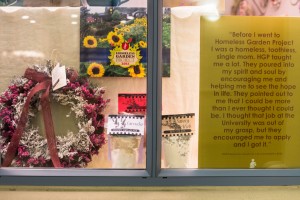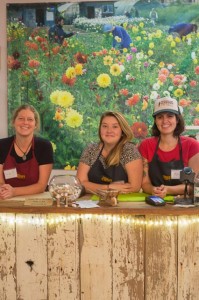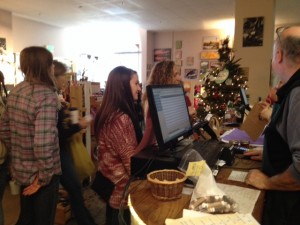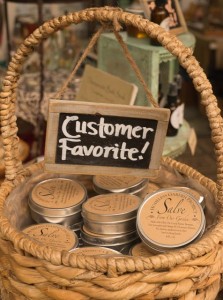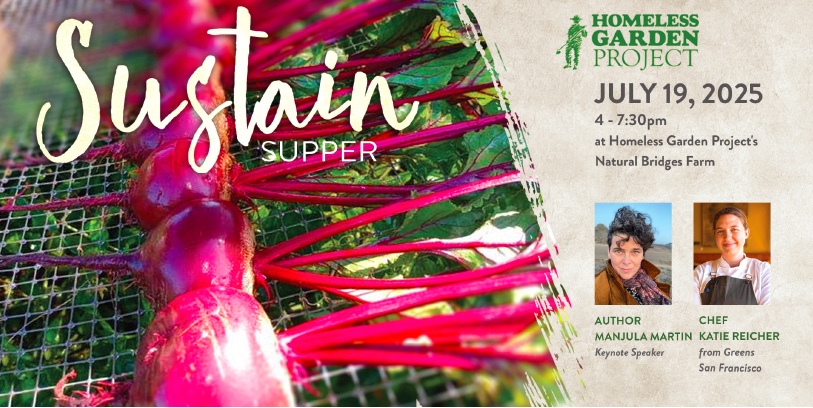Early on, the Women’s Organic Flower Enterprise filled a void in Homeless Garden Project’s training program during the winter months and held out the promise of earned income for the Project. In 2014, the Homeless Garden Project Store has done so much more than fill out the training program in the winter months. Today it’s at the center of a web of community ties–of people, actions, dreams, things made, and relationships created.
The desire for a sustainable community knits together many on both sides of the counter. Lizzie, a store volunteer, says, “I wanted to be involved with a community that cares about community health in a social way, a personal connection with other people, and a connection with food and land, all those things coming together.”
Amber, a customer with little time on her hands (She works three jobs) didn’t miss a beat when asked about her reasons for coming into the store: ”When I go to a regular store, I usually feel really guilty. By a normal store I mean stores where the stock is produced in other countries, or people aren’t paid very much, and there’s a huge distance that those goods have to travel, which results in environmental issues, so it’s a structure that I don’t support. Here I feel like I’m supporting something that I believe in. I feel like I’m giving something that feels more personal, even though I didn’t make it–that would be great if I had the time to make these things– it feels more personal than anything I could buy at just any shop because most of the things are different, because they actually are handmade.”
Other customers, from the young man with a black tousled beard to the slightly elfin-looking woman in a beige down vest–proudly told us they bought all their holiday gifts here every year.
Sometimes the connections are entirely personal and direct. Lizzie was surprised to find herself being treated to dinner by a fellow volunteer after the end of a shift. Ashton, a UCSC student who discovered HGP through Circle K International service club at College Eight, has spent a number of shifts as a greeter just outside the Cooper Breezeway leading to the store: ”Being a greeter, they just walk past you–but one guy said, thank you for your time. Even one homeless man told me, ‘Love you. Love you. I support one hundred percent what you’re doing. We need more people like you.”
Makers and manufacturers come with products in hand. On a Monday afternoon shift, Mary Jessen, owner of Deerhaven Soap in Bonny Doon, comes in with a hand truck laden with soap. Later, Anne Baldzikowski, author of Easy Artisan: Simple, Elegant Recipes for the Everyday Cook brings in a stack of books a few days in advance of her book signing. Anyone can ask Mary about Deerhaven Herb and Flower Farm. And who needs a carefully cropped corporate book blurb when the author is willing to let down her load, take a breath, and answer a few questions while she’s on the shop floor?
Anywhere else, a gift shop might simply offer a boutique experience. In that alternate world, customers see that products are handmade by people who are homeless, and politely think, isn’t that nice? At the HGP store, customers are often farmers, artists and craftspeople in their own right. At the register, a woman from Bonny Doon tells us about the half of a bee hive she inherited from a friend, the pleasure of harvesting the honey, and how to approach the mess that’s left over. Krista, a recently arrived Santa Cruz resident with a background in permaculture design, says: “I do similar things with succulents like what they’ve done here. I always propagate, and I’m always interested to see other ways of creating things–more than anything ideas for me to create from, but of course, I’m also buying gifts for people.”
In my two shifts as a store volunteer, I often gravitated to the art work of HGP trainees. They did all this work when the security of their housing was in doubt. Would I be able to engage in the creative process when confronted with this level of uncertainty? In that light, the pencil drawings by Angela Corrin and Stacy Child’s jewelry pieces made from ‘upcycled’ materials seem almost miraculous. Bredette Dyer’s written description of her work with essential oils touches on the courage needed for creativity: ”There is something to be said about being stressed, lost and at your wit’s end only to take a deep breath and to become enamored by aromatic bliss. . .My creations, like my life, are always a work in progress. Enjoy!”
With their work on the farm, and creative commitment at home, these trainees help build community in multiple ways. As for me, I was pre-occupied for a while by new tasks I had to learn–how to enter multiple quantities for a product, how to process a donation, remembering to charge 25 cents for gift bags, finding canvas tote bags in a hurry when customers needed something a little bigger for their purchases. And yes, mistakes were made. A woman asked me if we had any lavender essential oils, and I led her around the shop without ever stopping in front of the Deerhaven essential oils, just a step or two away from the Deerhaven soap display. Sorry, Angie!
But at some point, I found my own stake, and my own voice in this web of connections.
Having learned some of the rhythms of working at the register, I could look at customers directly and say, without hesitation, ”Thank you for supporting the Homeless Garden Project.”
– Quentin Hancock
Quentin is a writer and teacher living in Santa Cruz. He’s done a little bit of everything for the Homeless Garden Project: grant writing,
prospect research, fundraising, and washing dishes after farm suppers. He’s staffed the Farm Stand in a pinch, and (by now) the registers at the holiday store. He especially likes trading his desk for a knee pad, gloves and a chance to pull more weeds on the farm. He left the groves of academia six years ago to begin a career as a professional writer, and has written extensively about media, education and the environment. If you need a writer, editor or tutor, please contact John Q Public Communications at qhancock@cruzio.com.


